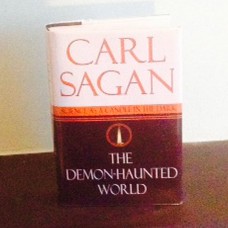Inspiring Older Readers
 posted on 11 Sep 2015
posted on 11 Sep 2015
The Demon-Haunted World by Carl Sagan
The premature death of the US cosmologist and astronomer, Carl Sagan, at the age of 62 robbed the scientific community of one of it’s most passionate and charismatic communicators. For those of us who remember his ground-breaking television series, Cosmos, it will be hard to ever forget the way he was able to make complex ideas accessible and even exciting. In many ways he was the first super-star, television-age science of the universe celebrity. We have become used to the big budget, CGI block-buster science shows that can be found somewhere on your television pretty much any night of the week but without Carl Sagan they would probably look quite different. The combination of the popular touch delivered without sacrificing scientific integrity is quite a difficult trick to pull off – and Sagan was the first to do it.
His 1995 book, The Demon-Haunted World, was published just a year before his death, and is, in my opinion, as ground-defining as his television show. This is a trenchant, humorous and ultimately deadly serious defence of science and the scientific method as you could wish to find. It is, he argues, our most important lodestone in a world drifting dangerously towards the irrational. For Sagan the sub-title of this book is probably the most important statement he could make – Science As A Candle In the Dark.
What clearly got right up Sagan’s nose was what he refers to as ‘pseudoscience’ – those beliefs that hold they have a scientific rationale but which on closer scrutiny are the worst kind of mumbo-jumbo. So the UFO nutcases, the alternative medicine brigade and the crystal freaks are all given a whacking. However, he doesn’t do this with bile or malice but with a sort of over-heated frustration. Why, he asks, would people fall for this tripe when the science properly conducted is even more thrilling and invigorating?
Religion doesn’t get out of this scot-free either and the dogmatic or fundamentalist tendency gets no truck. But this isn’t primarily an attack on religious orthodoxy as such. Sagan goes out of his way to acknowledge the extraordinary variety of the religious experience and the subtlety with which some of that is expressed by some of its advocates. Ultimately, however, this is an appeal to the secular in it’s proper sense of the word – a desire to see ideas scrutinised for their veracity and no ideology or set of ideas being given special or privileged consideration.
For me, this is a great book. I place it alongside one of my other all-time favourites the largely forgotten or ignored book by Dr Christopher Evans called The Cults of Unreason (which has a considerably more wicked and playful sense of humour) published some two decades earlier. Both books have a noble objective – to unmask the charlatan and to promote the values of the rational. However, it is clear Sagan felt the need to write his book more urgently, not because these pseudo-scientific cults are an easy aunt-Sally to knock over but because he was genuinely fearful that, as a civilisation, we are in danger of slipping back into the darkness of superstition and ignorance. The scientific method is clearly not the be-all and end-all of human existence but it is a critical tool in helping us confront those who want to drag us into the world of conspiracy theories, half-baked and half masticated solutions to non-existent problems and a critical shield against those who simply want to sell us snake-oil.
Terry Potter
September 2015